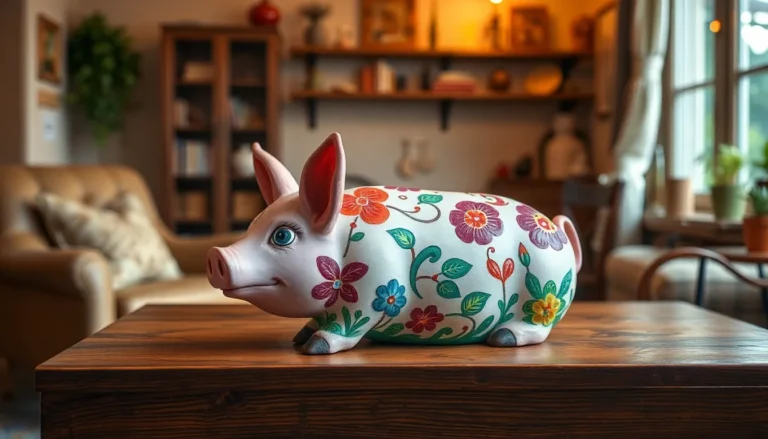In a world where DIY projects reign supreme, nothing quite beats the satisfaction of crafting your own glue at home. Whether it’s for a school project or a last-minute fix, homemade glue can save the day and your wallet. Why settle for overpriced store-bought options when you can whip up a batch of sticky goodness with just a few common ingredients?
Table of Contents
ToggleWhat You Need To Know About Homemade Glue
Homemade glue offers numerous advantages. It allows for creativity and customization, giving users control over ingredients and consistency. Common recipes often require basic supplies like flour, water, or corn syrup.
Safety is a priority with homemade options. Ingredients are typically non-toxic, making the glue suitable for children’s crafts. Long-lasting results can be achieved, especially when following recipes accurately.
Preparation methods vary widely. For instance, a simple flour paste consists of mixing equal parts flour and water until smooth. Another option is a cornstarch mixture, which combines one tablespoon of cornstarch with one cup of water over heat until thickened.
Storage can influence the glue’s shelf life. Homemade glue remains effective for one to two weeks when kept in an airtight container in the refrigerator.
Testing each glue for specific projects ensures the best outcome. Some projects may require stronger adhesion, while others may benefit from a more flexible solution.
Experimenting encourages innovation. Users can adjust ingredients for their specific needs or preferences, enhancing the crafting experience.
Cleaning up is straightforward. Warm soapy water typically removes any spills or excess glue from surfaces.
Homemade glue presents an affordable alternative to commercial products. Craft enthusiasts can save money while enjoying the satisfaction of creating their own adhesives.
Types Of Homemade Glue
Homemade glue comes in various forms, with each type serving specific purposes. Below are some popular options to consider.
Flour Glue
Flour glue is known for its simplicity and effectiveness. It requires just flour and water, making it accessible for most households. Typically, a ratio of one part flour to two parts water works well. Mixing these ingredients creates a smooth paste suitable for paper projects and light crafts. This glue sets quickly and dries clear, ensuring it doesn’t distract from the finished product. While it’s non-toxic, using it for indoor crafts is advisable, as it may attract pests if left exposed.
Cornstarch Glue
Cornstarch glue is another easy recipe that offers a strong bond. To prepare, combine cornstarch, water, and a splash of vinegar. Vendors often recommend using equal parts cornstarch and water for optimal results. Once mixed, heat this combination on the stove until it thickens. This adhesive works well for paper, cardboard, and fabric. Its non-toxic properties make it safe for children’s projects, while the vinegar acts as a preservative, extending its shelf life.
Milk Glue
Milk glue, or casein glue, utilizes protein found in milk to create a strong bond. The preparation involves mixing milk with vinegar, allowing the mixture to curdle. Straining the curds and then blending them with a bit of water produces an effective adhesive. This glue is ideal for wood and paper crafts. Drying clear, it creates a durable bond ideal for various materials. Eco-conscious crafters appreciate its biodegradable nature, making it a top choice for sustainable projects.
Step-By-Step Guide On How To Make Glue At Home
Making glue at home is simple and rewarding. Gather familiar ingredients for effective and versatile results.
Ingredients List
Basic ingredients include flour, water, and optional vinegar or sugar. Flour acts as the primary base, contributing to the glue’s consistency. Water dilutes the flour, helping to achieve the desired thickness. Vinegar enhances the adhesive properties, while sugar adds sweetness and improves texture. For cornstarch glue, cornstarch replaces flour but maintains similar principles. Each ingredient plays a crucial role in ensuring the final product adheres well to various materials.
Preparation Process
Start by measuring one part flour and mixing it with two parts water in a bowl. Stir the mixture until it forms a smooth paste without lumps. Next, heat the mixture on low heat for about five minutes, continuously stirring to prevent sticking. Remove from heat once it thickens. For cornstarch glue, combine one part cornstarch with two parts water and a splash of vinegar, then follow similar heating instructions. Allow the glue to cool before use. Store any leftover glue in an airtight container to maintain its effectiveness for one to two weeks.
Tips For Using Homemade Glue
Utilize homemade glue within one to two weeks for optimal effectiveness. Store the glue in an airtight container to prevent it from drying out. Test the glue on a small area of the project first to ensure compatibility and desired results. Apply the glue evenly to avoid clumps that might cause uneven surfaces or weak bonds.
Consider adjusting the thickness of the glue by adding more water or flour based on specific project needs. Keep a damp cloth nearby for easy cleanup after application, making it simpler to remove excess glue. Reinforce edges with additional glue if the initial application doesn’t provide a strong bond.
Choose the right type of homemade glue for different materials. Flour glue works well with paper projects, while cornstarch glue is more suitable for fabric and cardboard. Milk glue is recommended for wood projects due to its strong hold and biodegradable properties.
Experiment with various recipes to discover the best glue for personal crafting preferences. Try enhancing glue strength by adding a few drops of vinegar or sugar to the mixture. Avoid mixing different types of glue together, as this may alter their properties and effectiveness.
Consult trusted sources to find creative uses for homemade glue beyond basic crafting. For instance, it can serve as a base for decoupage projects or as an adhesive for creating art with natural materials. Enjoy the crafting process by customizing glue recipes to suit specific projects, ensuring a satisfying and effective outcome.
Storage And Shelf Life
Proper storage significantly impacts the effectiveness of homemade glue. Airtight containers, such as jars or plastic bottles, prevent air exposure and keep glue from drying out. The glue maintains its usability for about one to two weeks when stored this way.
Chilling extends the shelf life even further. Placing the container in the refrigerator can help prevent spoilage, allowing the glue to last up to a month. Be aware that some types of glue, like milk glue, may spoil sooner, often within a week.
Before using stored glue, always check for changes in texture or smell. If the glue appears lumpy or has an off odor, it’s best to discard it. Consistency matters; the glue can thicken over time. Adding a bit of water can restore its original texture, but it’s important not to dilute it excessively.
Testing the glue on a small area remains a sound practice. This ensures it still provides a proper bond without compromising the materials. Storing the glue in a cool, dark place further enhances its longevity.
Different glue types may require unique storage solutions. For example, flour-based glues need a dry environment, while cornstarch glue can tolerate slightly more humidity. Always label containers with the type of glue and the date made to track shelf life easily.
Storing homemade glue with care not only reduces waste but also ensures reliable results for future crafting projects.
Conclusion
Making glue at home is not just a fun activity but also a practical solution for many crafting needs. With simple ingredients like flour or cornstarch, anyone can create effective adhesives tailored to their projects. This DIY approach encourages creativity and customization while being safe for children.
By following the outlined recipes and storage tips, users can enjoy the benefits of homemade glue for a variety of applications. From paper crafts to quick repairs, the possibilities are endless. Embracing this eco-friendly alternative not only saves money but also enhances the overall crafting experience. So go ahead and experiment with different recipes to find the perfect glue for every project.





